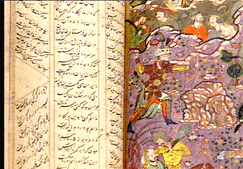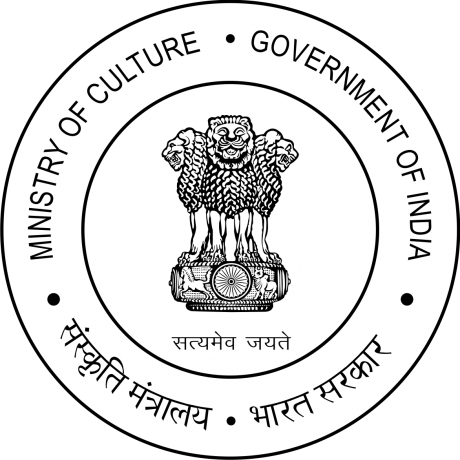
MANUSCRIPT COLLECTION OF THE SOCIETY is varied and rich, and covers most of the Indian languages and
scripts and even several Asian ones, e.g., Assamese, Bengali, Gujarati, Gurumukhi, Kanarese, Urdu, Marathi, Modi, Nagari, Newari, Oriya, Rajasthani, Sarada, Armenian, Sinhalese, Arabic, Persian, Pushto, Javanese, Turki, Burmese, Chinese, Siamese, Tibetan etc. The materials used for the manuscripts are also varied: palm and palmyra leaves, barks of different trees, papers of various grades.
FOUR SECTIONS
(a) Sanskritic Section : This Section comprises of manuscripts in Sanskrit and Modern Indian Languages, which range in date from the 7th Century A.D. and number about thirty thousand. Rich and varied in textual contents the collection is an epitome of India's achievements in diverse spheres of life and learning. Some of the manuscripts have fine miniature illustrations, the earliest of which belongs to the 10th Century A.D.
(b) Islamic Section : This Section comprises of manuscripts in Arabic, Persian, Turkish, Pushto, Urdu, etc. numbering more than seven thousand, ranging in date from the first quarter of the 12th Century A.D. Some of the manuscripts belonged to the Mughal Imperial Library, Tipu Sultan's Library and Fort William College Library. Some are extremely rare and some are rich and varied in textual contents. They cover every branch of Islamic history and learning. In some, the calligraphy is most excellent while a few others bear miniature paintings of high quality and style, some of them being autographed.
(c) Sino-Tibetan and South-East Asian Section : This Section comprises of manuscripts and Xylographs in Burmese, Chinese, Tibetan, Siamese etc. Chinese manuscripts relate to Chinese translations of the Indian Buddhist texts, while the Tibetan group includes the entire set of the Kangyur and the Bstangyur, besides also individual Xylographs and manuscripts. Manuscript works in Burmese, Siamese, Javanese, etc. are interesting for studies in the history and culture of these countries and also for study of Buddhism.
(d) English Section : This Section comprises a few English manuscripts in the Society. These are from Nathaniel Halhed, James Prinsep, Buchanan Hamilton, Alexander Csoma de koros and others.
Sanskritic: The manuscripts cover the period from 7th c. A.D. down to the 19th century. These are useful source materials to illustrate the development of the Indian scripts (especially Bengali, Nagari etc.). The colophons and post-colophons contain information relating to socio-economic conditions of the people. Besides, they help us to fix the chronology of the Royal dynasties of India. Where the inscriptions fail to ascertain dates and chronology, the manuscripts may throw some light, provided a thorough critical study of these and their colophons and postcolophons were made.
Some of the rare Sanskrit manuscripts may be mentioned here. Brihati (from Kavindracharya's collection), Amrita Vindu (11th c.), Kiranavali, Charucharya, Nartaka Nirnaya, Parasika-prakasa, Sanskrita-ratnakara, Lalitavistara, Horoscope of a muslim of the Mughal Court (1640 A.D.) A Deed of Mortgage (1639), Ramayana (Bengali) of Ramananda Yati, Vajrayana text (11th c.), a text on Buddhist Nyaya, Rigveda Padapatha, Laghu-Kalachakra-tika, Kalachakravetara, Kuttanimatam, Vajravalinama mannadalopayika, Ramacharita of Sandhyakar Nandi, Bhattikavyatika of Srinivasa, and Paragali Mahabharata.
The manuscript of Kubjikamatam is of the 7th Century A.D. The manuscript of Rigveda Padapatha, copied in 1362 A.D., is perhaps "the oldest manuscript of the Rigveda."
Islamic : Of the many Islamic Manuscripts there are some which are extremely rare and unique. Of these only a few may be mentioned: Tahdhib Sharh As-Sab' at Mullaqat (early 12th c. Arabic), Qalaid al-Iquian wa Mahasin al-Ayan (12th c.), Kharidat al-Qasr (12th c.), Al-Jam Baynas as-Sahihin abridged version with autograph, (13th c.), A-Madkhul(13th c.), Tafsir-i-Quran (Persian, 13th c., important also for calligraphy), Tuhfat al-Ahbar fi usul at Hadith wa'l Akhbar (15th c.), Kitab al-I'lan (18th c.), Saha' if-i-Shara' if or Duraral Mansur (Persian, 19th c., an autographed copy), and Adab-i-Alamgiri (18th c.).
Illustrated Manuscripts :: There are large numbers of illuminated and illustrated manuscripts of different schools, many of which are unique for their calligraphy, delicacy of their lines, and elegance of composition and charming colour schemes. These miniatures still afford glimpses of India's past achievements, Of these unique manuscripts (earliest belonging to the 10th Century A.D.) mention may be made of a few: Astasahasrika Prajnaparamita, Aparimitayurnama Mahayana sutra, Pancharaksha, Paramarthanama Sangati, Devimahatmya, Viveka Panchamrita, Bhagavatgita, Shahnama, Kullayat-i-Saadi, Suwaru'l aqalim, Farang-i-Aurang Shahi, Ain-i-Akbari, Diwan-i-Makhfi, Qissa-i-Nush-Afarin, Jamiut-Twarikh, Amir nama Tutinama, Iyar-i-Danesh, Bihar-i-Danesh, Tarjuma Mahabharata, Tafribul-Imarah (by Silchand, dedicated to J. H. Lushington), and Imaratut-Akbar (by Chitarmal for James Duncan).
Many scholars are using the collection for editing their texts and for translation in modern languages.
Archives/English Manuscripts : In the Library there are preserved a large number of old letters some of which date back to1784, just after the Society was founded. These letters were received by the Society from persons belonging to different walks of life, requesting information on such subjects as old and rare manuscripts, ancient monuments, coins etc. Some among the writers of these letters were persons well known for their literary, scientific and other cultural accomplishments. These old files constitute important documents relating to the history of the Society, as also of many other scientific and humanistic organisations that were established in India either in the 19th or in the 20th century.
Reprography and Conservation There is a Conservation Unit for repair of fragile books and manuscripts.
The Reprographic Section provides microfilms, microfische and photocopies of Society's manuscripts and printed materials to the readers, members, researchers and institutions.
Urdu : The Society has a fine collection of about 234 Urdu manuscripts many of which were received as a gift from the Fort William College (founded in 1800), Fort William College decided to award prizes, at the instance of J. S. Gilchrist, for standard original and translated works in the Hindusthani language, produced in the College.
Sino-Tibetan and Burmese : The Society has a complete set of Kanjur and Tanjur texts of the Buddhist scriptures and some extra-canonical works. These were collected by B. H. Hodgson and A. Csoma de koros. A section of the collection has been catalogued. There are over one hundred titles of Chinese books, some of which are rare and valuable for Chinese studies. These cover almost all the subjects relating to Chinese Culture, Civilization and Science and Buddhism. Subjects covered include Classical Literature, Language. History, Geography, Topography, Philosophy, Religion, manners and customs, biography of scholars, sciences (Botanical, Astronimical, Zoological).
The Society has a valuable collection of about 162 Burmese manuscript written on parabaikes and palm leaf. The manuscripts deal with Buddhistic texts, Religion, History of the world and also of Burmja and Arakan, works on Gramour (including that of kaccayana) and Rhetoric, Buddhist cosmography, Astrology, Medicine etc.
Bengali Manuscripts : Other than Sanskrit, a few Bengali manuscripts have been found written by Bengali Brahmins residing in Varanasi. Parageli Mahabharat, Chuti Khan'sAsvamedha Parva, and many other important manuscripts were purchased. Mss. donated by Justice Ramaprosad Mukherjee and Sri A Roy enriched the collection. Now we have 703 Bengali Mss. and 12 Assamese manuscripts in the collection of the Asiatic Society. It comprises Asiatic Society's own collection, Government collection, Indian Museum collection and donors' collection. At present, the collection of Bengali manuscripts in the possession of Asiatic Society is rich in respect of number and rarity. The Society has manuscripts on Ramayana, Mahabharata, Srimadbhagavat, Mangala Kavyas, treatises on Vaisnava faith and its allied subjects. Folk literature, erotic verses and Vaisnaba Sahajiya Cult etc.
Rajasthani : The Society possesses very rare, valuable and important Rajasthani Manuscripts which date the pre-middle and middle years under the guidance of Dr.Sukumar Sen, the Society prepared and brought out a descriptive catalogue, Part I, of the same in 1957, comprising 114 manuscripts, now we have total 636 Rajasthani manuscripts, recently Society published the second part (Part II) of descriptive catalogue of Rajasthani manuscripts comprising remaining 522 manuscripts.

